West Hartford Businesses Face Extended Closure from New Executive Order

Audio By Carbonatix
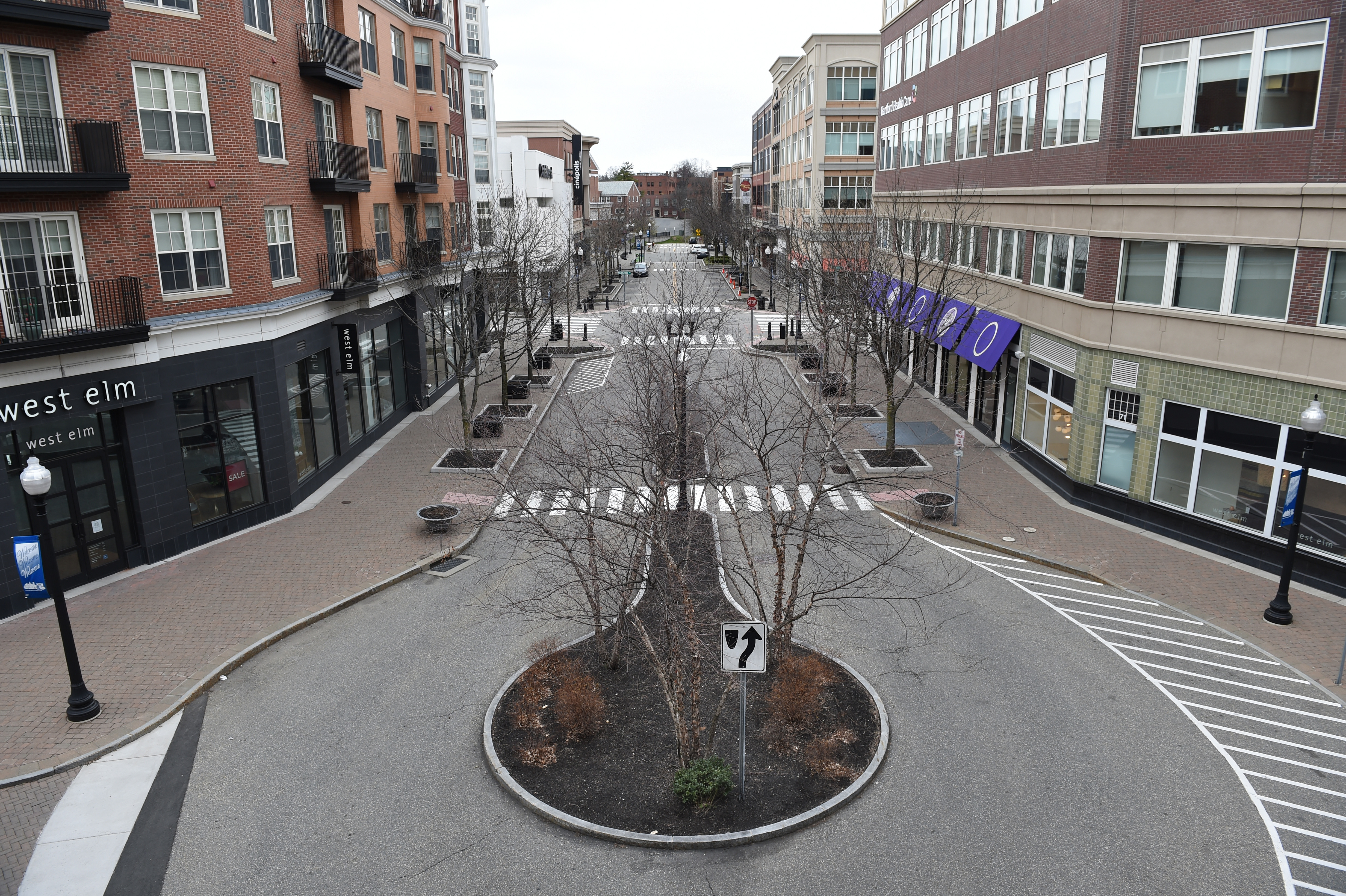
Blue Back Square is like a ghost town, void of shoppers, diners and workers, due to the COVID-19 pandemic. Photo credit: Cloe Poisson, CTMirror.org
An executive order signed by Gov. Ned Lamont on Friday extended the closure of restaurants, gyms, and other businesses until May 20, as DPH reports 98 new hospitalizations, 754 new cases and 98 additional deaths.
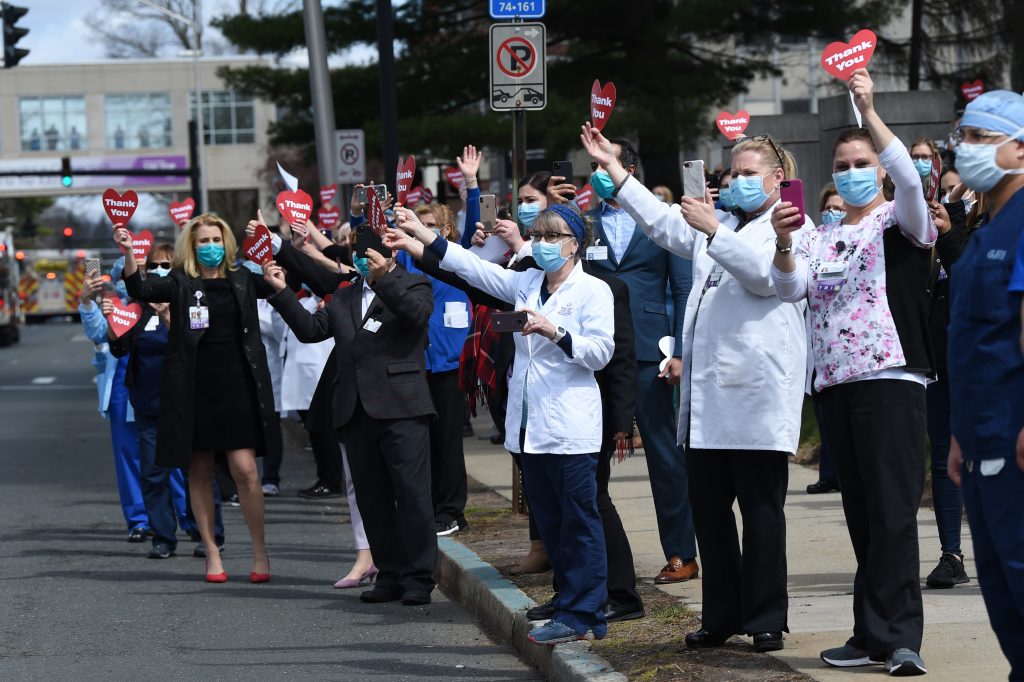
Health care workers at St. Francis Hospital who are on the front lines caring for patients with COVID-19 cheer and wave red “Thank You” hearts as a parade of first responders passes by to pay tribute to them Friday at noon. The parade included representatives of local fire and police departments as well as EMS workers. Photo credit: Cloe Poisson, CTMirror.org
By Mark Pazniokas and Gregory B. Hladky, CTMirror.org
West Hartford-specific information provided by Ronni Newton, We-Ha.com
West Hartford’s restaurants will be closed to on-premise dining, and non-essential retail stores, gyms, movie theaters, and many other businesses and retail operations, including Westfarms and Blue Back Square, will need remain closed until May 20.
Social gatherings will remain restricted to no more than five people through May 20 as well.
Gov. Ned Lamont’s Executive Order 7X, extending the closure of schools, restaurants and many businesses until May 20 is generating the first significant political blowback to his handling of the COVID-19 crisis since declaring a public-health emergency a month ago.
With varying degrees of frustration and restraint, legislative leaders and others are complaining that the extension was a premature jolt to fragile businesses and anxious residents, even while they acknowledge continued restrictions may prove necessary by month’s end.
“The bottom line is you didn’t need to add three weeks to an existing executive order,” said House Minority Leader Themis Klarides, R-Derby. “It made people more panicked, more anxious. As a leader, it is our job to manage all that. It’s a very difficult balancing act, and I recognize that.”
Senate Minority Leader Len Fasano was even more critical.
“You need someone who is the leader of the state to say, ‘I’ve got a plan to phase in the reopening of the state at the appropriate time. And here’s what the plan is going to look like.’ All we get is we’re not going to open until until May 20,” said Fasano, R-North Haven. “To me, that’s almost irresponsible.”
The administration’s daily COVID-19 conference call with legislative leaders quickly turned heated Thursday once the topic turned to Lamont’s decision to extend his closure orders from April 30 for schools and businesses until May 20, lawmakers and the governor’s chief of staff acknowledged Friday.
The discontent became public on Good Friday, the start of an Easter weekend overflowing with symbols of hope and rebirth, as the governor spoke about signs that weeks of ever-tightening social-distancing rules were slowing the spread of the novel coronavirus. He likened them, and stories of altruism during the crisis, to the first green shoots of spring.
“These are all the green shoots of what this weekend means for me, what it means for the state of Connecticut,” Lamont said.
But preliminary evidence of the pandemic easing is building pressure on Lamont to answer two questions: What will be the standard for judging when it might be safe to begin easing restrictions? And when that time comes, how gradually will those restrictions be relaxed?
“I’m really relying on the health care experts, looking at when we think we have this virus contained, when I think I can test workers and know that they’re safe to go back to work and won’t be able to infect others,” Lamont said.
Lamont could not identify concrete metrics that would tell him and the public when social distancing might be relaxed. He said no one has produced such a measure, not even the Centers for Disease Control and Prevention.
“Right now, the CDC has been silent on this, but I do know they are looking into this and trying to come up with some metrics,” Lamont said. “Obviously, every region is going to be quite different in terms of the infection rates and the such. Southern Connecticut in particular is part of that hot zone that includes the New York metro area.”
The Department of Public Health reported 98 new hospitalizations Friday, 68 additional deaths associated with COVID-19 and 754 new laboratory-confirmed cases.
Of those 68 deaths, DPH said that 49 represented deaths previously unreported for persons who died between March 30 and April 8 without being tested for COVID-19, but for whom a death certificate listed COVID-19 as a “cause of death or a significant condition contributing to death.” Nineteen of Friday’s reported deaths were for persons who had tested positive for COVID-19.
In West Hartford, the total number of confirmed positive COVID-19 cases increased by six, from 69 to 75. Demographic information was not immediately available.
The state now has 1,562 current hospitalizations due to COVID-19, well within the capacity of the state’s hospitals. There are 10,538 confirmed cases and 448 fatalities.

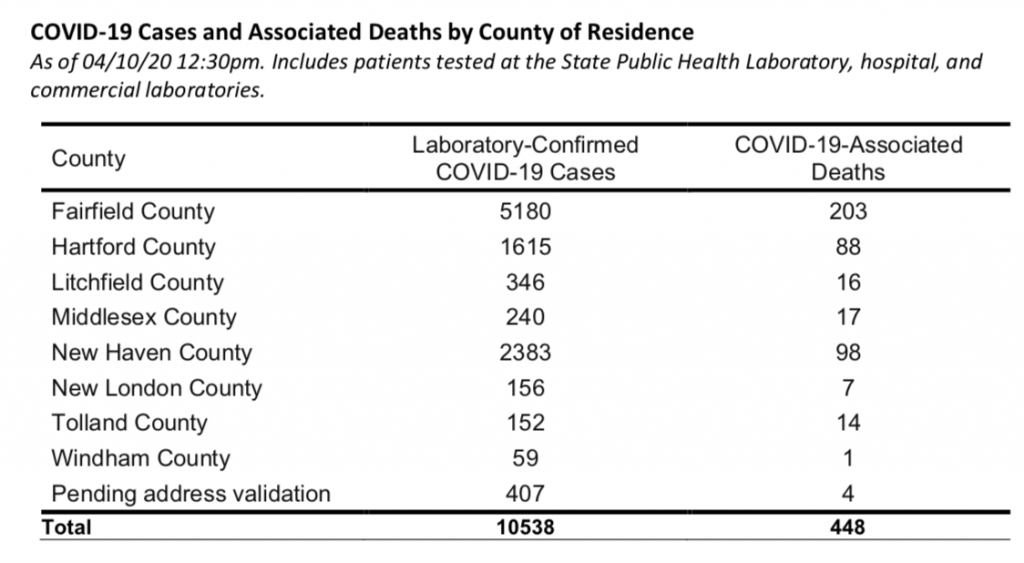
As Lamont was broadcasting a virtual press conference from the State Capitol Friday, Hartford HealthCare officials a few blocks away released a predictive statistical model developed with MIT that seemed to reinforce that social-distancing restrictions ordered by Lamont and other governors were effective.
Connecticut will hit the peak of its confirmed COVID-19 cases on or about April 21 and coronavirus-related deaths in this state are likely to reach 2,626 by mid-June, according to the model.
The model now projects virus-related deaths in the U.S. reaching more than 71,000 by June 14, a figure significantly lower than some earlier predictions about the pandemic’s deadly impact.
But Dimitris Bertsimas, an MIT associate dean and head of the analytical team that developed the model for predicting the course of the COVID-19 pandemic, warned that failure to continue social distancing and to do widespread testing could lead to far more deaths.
Bertsimas said he is “very confident” that a too-swift relaxation of precautions in the U.S. will lead to a second wave of coronavirus infections and deaths, creating a “much worse environment than we have now.”
Most of the criticism of Lamont was nuanced. It was less about a demand for reopening schools and businesses on a certain date than a complaint the administration needed a more sophisticated risk-benefit analysis over the social and commercial restrictions that quickly put 300,000 people out of work and left vulnerable children at risk.
“It’s not about the date. That’s going to be driven by scientists, and it should be,” said House Majority Leader Matt Ritter, D-Hartford.
Ritter said there is an impatience to know what the easing of restrictions will look like. If the barbershop can re-open, will it be one customer at a time? Will the barber have to take a customer’s temperature?
“I haven’t seen that anyplace in the country, not just Connecticut,” Ritter said.
Rep. Dave Rutigliano, R-Trumbull, a restaurateur, said he expected the administration would explore those questions for a few weeks before deciding if an across-the-board closure order should be extended for three weeks. But Rutigliano said he is not suggesting a timetable for reopening.
“I’m not this crazy guy who thinks all restaurants and bars should be open tomorrow,” Rutigliano said.
Small businesses, however, are desperate for a sign that the state is at least thinking about what the hospitality industry will look like, he said.
“You know damn well we aren’t going to unlock the door one day and it’s going to be back to normal,” he said. “It’s going to be some sort of phase-in.”
Rep. J. Vincent Candelora, R-North Branford, a deputy GOP leader who participates in the administration’s daily conference calls, expressed both empathy for and frustration with the governor and his administration.
“They are putting out more brush fires than we could ever imagine,” Candelora said.
But Candelora is frustrated by what he sees as an inability to shift to a more sophisticated risk-benefit analysis. Understandably, Candelora said, the focus has been on slowing the spread of the contagion to keep the health care system from being overwhelmed.
“I’m not saying open up the floodgates today,” said Candelora, the owner of a sports complex closed by the governor’s orders. “The modeling that we’re seeing says the social distancing is working. Why make a decision that makes it appear that it is not working, when the data is actually showing the opposite?”
Candelora said the impact on small businesses like his are significant, but he is more concerned about the significant risk to the safety and physical and mental health of the state: The schools play an important role in protecting children who may be at risk to abuse; and isolation exacts a heavy price on some people.
“I have a friend who is 50 and cancelled all his chemo, not because he doesn’t have access, but he has no hope with the way this is going with the virus. He said, ‘Forget it. I’m done.’”
Candelora challenged the administration to consider opening some schools in eastern Connecticut, where the number of cases, hospitalizations and deaths are currently low.
“Eastern Connecticut has almost no indications of a pandemic and, and they are falling under the same order as Fairfield County. I don’t understand why children in Pomfret can’t go back to school?” Candelora said.
Paul Mounds, the governor’s chief of staff, said Connecticut is small enough for one set of restrictions. He noted that Lamont was one of the governors who have worked to developed a regional, multi-state approach.
The governor is thinking about what will happen when the pandemic eases, and he has tried to share his thinking, Mounds said.
“It started last week with that presentation the governor made with the modeling showing not only the coming peak of cases statewide, but the rolling peaks in the counties,” Mounds said. “That was giving people fair notice what we were up against.”
COVID-19 is caused by a novel coronavirus, and the science behind the best practices for how it will behave and how it is best contained is shifting. Mounds said the Lamont administration will be guided by the CDC and other public-health experts.
“We just have to trust the information in front of us. That is what we have been doing,” Mounds said.
Ongoing social distancing combined with widespread testing of the population will be essential if the U.S. is to avoid a major revival of the pandemic, warned Bertsimas, the MIT associate dean.
Bertsimas cited the 1918 Influenza pandemic experience as a major warning signal. The first cases of what was then called the “Spanish Flu” occurred in the U.S. in March 1918. But 70 percent of the deaths that resulted from that flu happened during the second wave of the disease in the autumn of 1918.
Influenza killed an estimated 195,000 Americans in the month of October 1918 alone. Global fatalities attributed to the Spanish Flu have been estimated at 50 million, and an estimated 675,000 people in the U.S. died from the disease.
Connecticut deaths from the 1918 pandemic were estimated at about 9,000.
Several weeks ago, some models cited by the White House indicated COVID-19 deaths in the U.S. could range from 100,000 to more than 200,000. But Bertsimas said the MIT model was consistently predicting the death toll would be closer to 71,000 in the U.S.
Bertsimas said the model developed by his team “is far more detailed” that other statistical models being used to predict how the COVID-19 pandemic will develop. “So far, it has been reasonably accurate,” he said.
The MIT model’s forecast is close to that from one more-widely publicized analytical system developed at the University of Washington, which is now predicting a total of about 60,000 U.S. coronavirus deaths.
Bertsimas said social distancing and economic restrictions are crucial in the efforts to reduce the spread of the disease. He cited the decision by California officials to effectively shut down that state a week earlier than New York did, saying the result was that New York had ten times as many deaths and infections.
“A week earlier or a week later makes a material difference in infections and deaths,” Bertsimas said.
Bertsimas said widespread testing for the disease will be critical in the effort to return the U.S. to a more normal status. He said nations that have been successful in curbing the coronavirus infection rate and reducing the number of fatalities have relied on broad scale testing to determine who has the disease, who has recovered and who may still be a carrier.
“What we can do is accelerate our testing capabilities,” Bertsimas said.
The Lamont administration agrees.
Reprinted with permission of The Connecticut Mirror. The author can be reached at [email protected].
Like what you see here? Click here to subscribe to We-Ha’s newsletter so you’ll always be in the know about what’s happening in West Hartford!


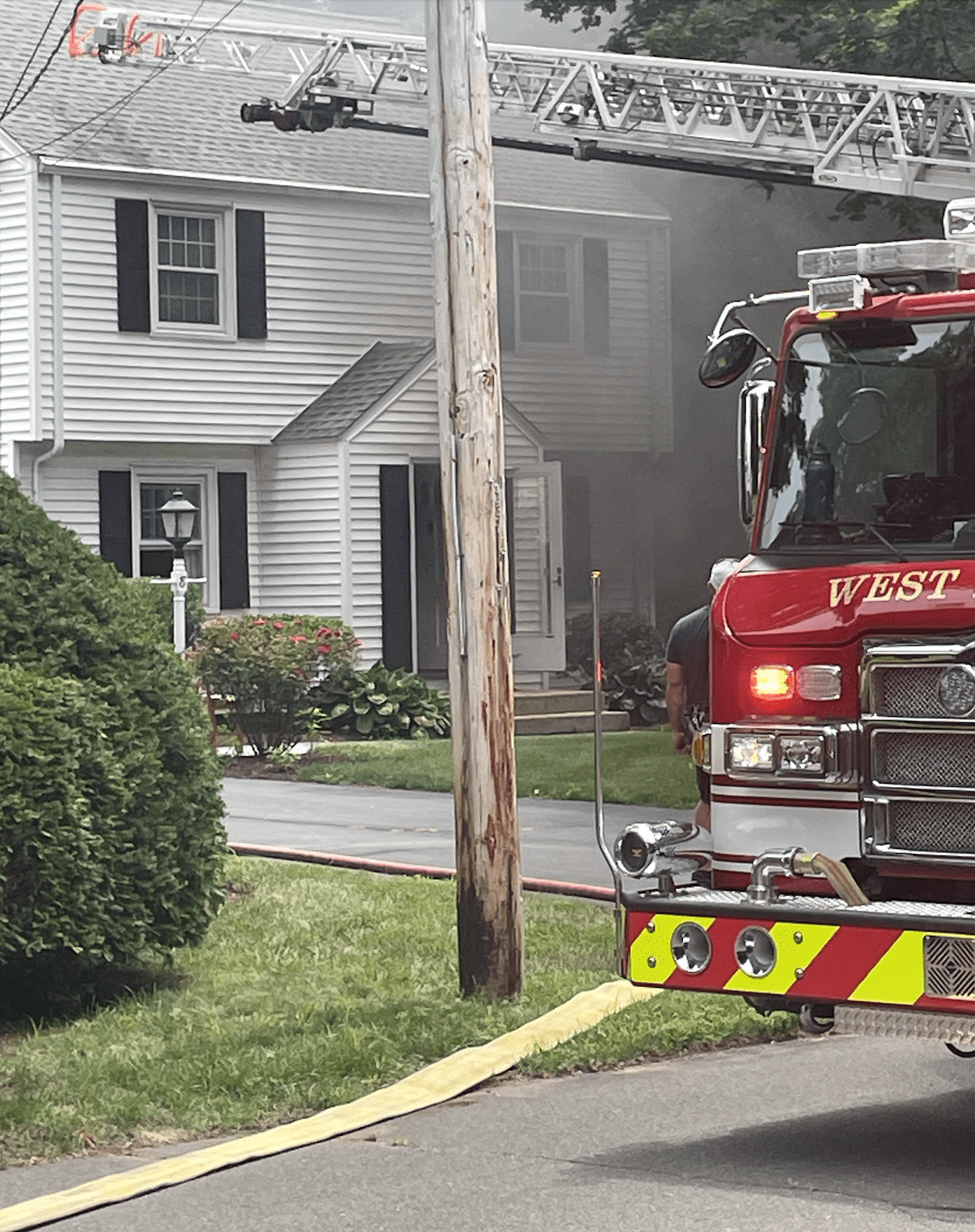
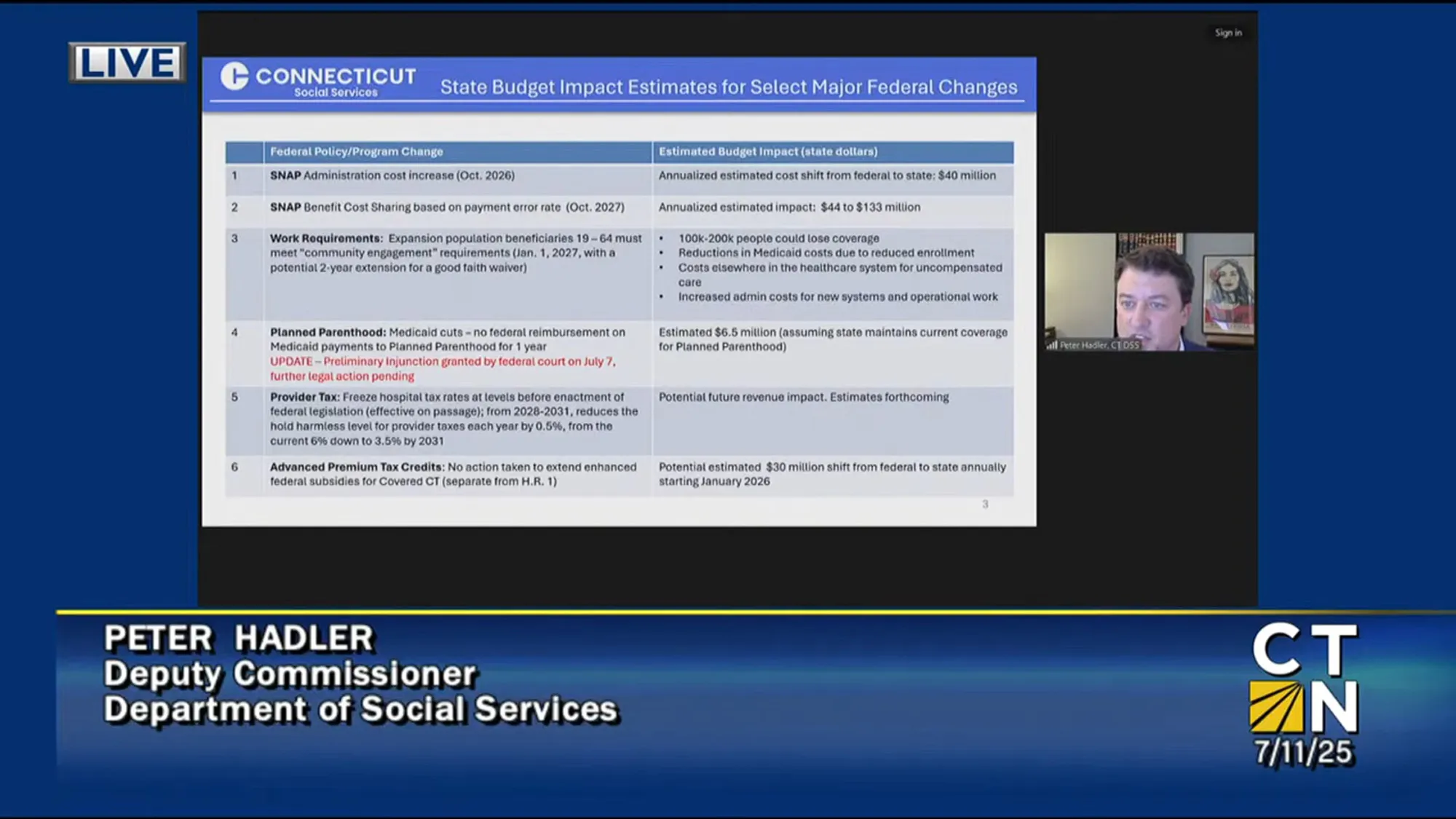
April 11, 2020 To the Editor: Thank you for reminding us that, for public health and safety reasons, “Social gatherings will remain restricted to no more than five people through May 20[, 2020 ….” I am distressed to report that today, far too many people are either ignoring or showing reckless disregard for these simple rules that are designed to protect us all. On April 11, 2020, many clusters of more-than-five people were observed gathering, closely together, at various locations on Lasalle Road and Farmington Avenue in West Hartford Center. Many in these clusters, and many just out on the streets, were not wearing protective nose-and-mouth coverings. These individuals may not feel “ill” but they well may be COVID carriers. They present an irresponsible and unnecessary danger to the rest of our community when then flaunt rather easy-to-follow directives. Perhaps those of us who follow the rules should, from a safe distance, take photographs of the social-distance violators and send those photographs to the Board of Health or to the Mayor’s office for follow up?
[…] ICYMI, along with extending the date that brick and mortar schools must remain closed, Gov. Ned Lamont last week also extended the date that restaurants (for on-premise dining), movie theaters, and other businesses deemed “non-essential” must remain closed. For businesses that are open, physical distancing must remain in place and grocery stores must limit the number of people who are in the store at any time. Click here for further details. […]